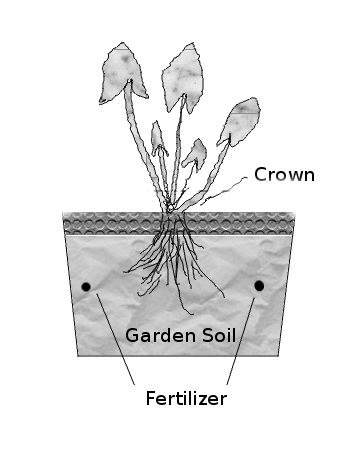Planting Shallow Water and Bog Plants (aka Marginal or Upright Plants)
Marginal plants grow with their leaves upright, above the water (emersed) and their roots anchored in soil or gravel. They generally grow around the margins of a pond or stream, so are often referred to as marginal plants. They are also often referred to as bog plants, although it is more accurate to separate them into 2 categories--shallow water plants, which may be planted either in moist soil or shallow water with water over the crown of the plant, and bog plants, which should be planted in moist soil only, with no water over the crown of the plant. Examples of popular shallow water plants are cattails, arrowheads, pickerel, and aquatic iris. Examples of popular bog plants are blue lobelia, variegated spider lily, buzz buttons, and gunnera.
Most upright plants come in small pots. Care should be taken when removing the plants from these pots. If the roots of the plant are growing out of the net pots, carefully cut the net pot apart and remove whatever you can of the old pot without disturbing the roots. Do not disturb the roots any more than necessary, and do not wash the soil off the roots. Fill the planting container about 3/4 of the way to the top with an aquatic soil* or media. Then make a hole in the center large enough for the roots to fit in without planting the crown of the plant too deep--it should be at or just under the soil surface. While holding the plant upright in the hole, carefully fill in the hole with soil around the roots. Lightly pack the soil down so it will be firm enough to hold the plant upright. After planting, place the plants in a shady area for them to adjust to the sun, wind and outdoor environment, as most of the plants are coming out of a greenhouse and need a couple of days to adjust to being outside. Once they are established and growing well, they may be placed in their permanent position.
Plants may also be planted directly into a soil bottom pond and into the gravel of a plant filter, or the roots loosely wrapped in burlap or landscape fabric and inserted between rocks and cracks of waterfalls and streambeds. We also recommend leaving soil intact in these situations, although "extra" soil not penetrated by the roots may be removed.
If we do ship plants "bare root", some will come as unrooted cuttings (these varieties root quickly and easily), but most will come as a wedge of soil with roots and leaves. Do not wash the soil off, as this will damage the roots and make it more difficult for the plant to adjust.
*For soil, use a soil or media specifically marketed for aquatic plants. Alternatively, simply use a good topsoil out of your garden. If possible, use a soil which is has sandy loam and clay in roughly equal amounts, although most plants will adapt to anything from a very sandy soil to a soil of pure clay. So long as the topsoil does not contain too much organic material, it should work (don't use straight compost!) Terrestrial potting mix for gardens or houseplants is not a good idea--it is absolutely bad, bad, bad! Terrestrial potting mixes use all light-weight ingredients, which may float out of the pot and scatter in the pond, and are not heavy enough to keep the plant from blowing over in the wind. Moreover, many of the ingredients will be organic (bark, peat, etc) that will decompose underwater. Organic decomposition uses a lot of oxygen in a terrestrial setting, but since water only holds around 10 parts per million oxygen, rather than around 20% in the air, a lot of organic material underwater will primarily be decomposed by bacteria in anaerobic conditions, and this will give of byproducts that are toxic to the plants.
For specific planting depths and type of container to use, read the plant information at the bottom of the item description for the plant you are planting.
